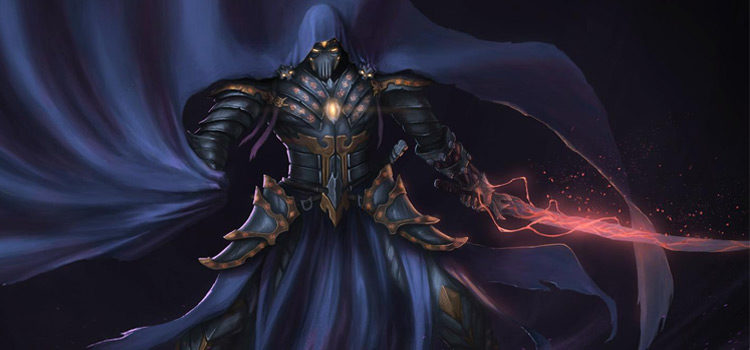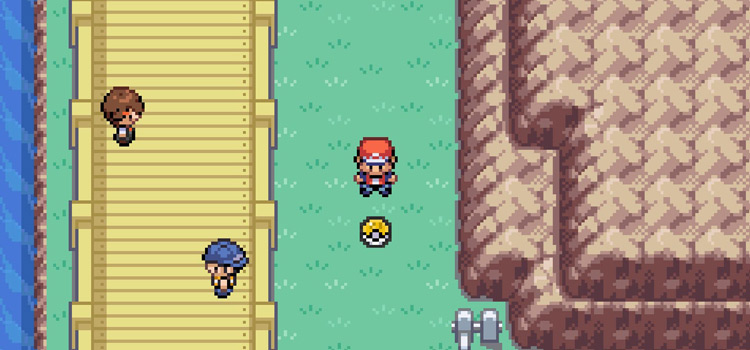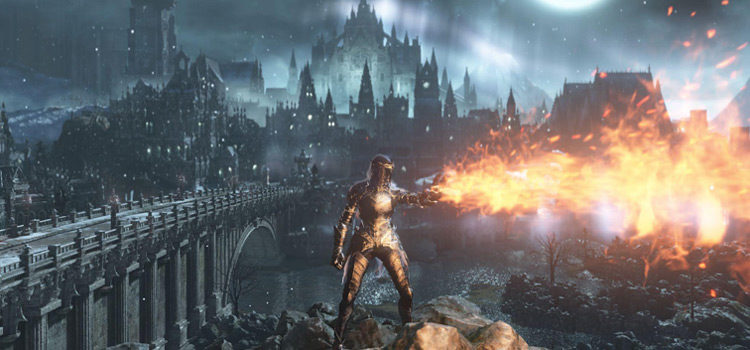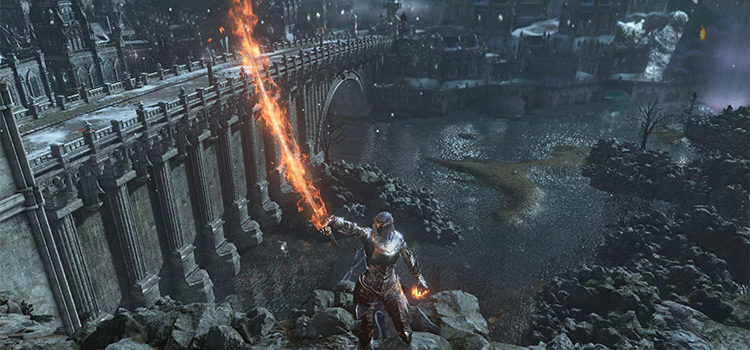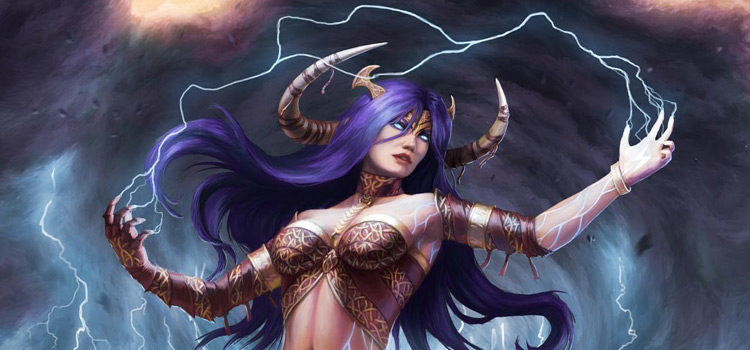Green-Flame Blade & Booming Blade: D&D 5e Spell Guide
This post may contain affiliate links. If you buy something we may get a small commission at no extra cost to you. (Learn more).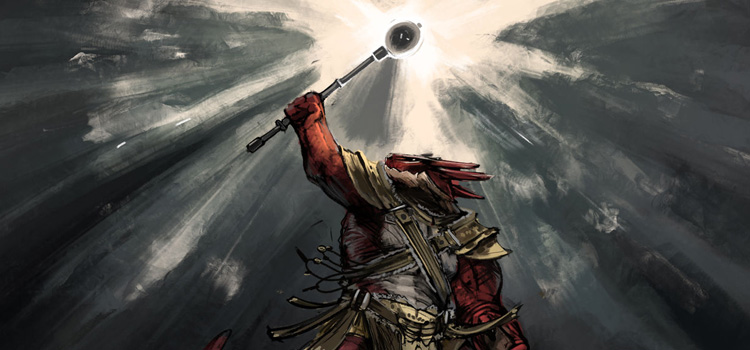
For decades, some D&D players have wanted to bring magic and spells into melee, rather than stand at the back of a formation, tossing fireballs at opponents from afar.
Two cantrips have become a staple of this fighting style in 5e: green-flame blade and booming blade.
Green-flame blade and booming blade are relatively new spells to D&D. Especially compared to long-running favorites like fireball.
In 4th edition, these spells were unique to the swordmage: a defensive mage/fighter hybrid class that was released in the Forgotten Realms Player’s Guide.
These spells were released in the Sword Coast Adventurer’s Guide, and have now been changed with the release of Tasha’s Cauldron of Everything for 5e.
So let’s take a look at how they function now.
What Do They Do?
Green-Flame Blade
Type: Evocation Cantrip
Casting Time: One Action
Range: Self (5 ft.)
Components: S, M (a melee weapon worth at least 1 sp)
Duration: Instantaneous
Booming Blade
Type: Evocation Cantrip
Casting Time: One Action
Range: Self (5 ft.)
Components: S, M (a melee weapon worth at least 1 sp)
Duration: 1 Round
As part of both of these spells, you make a melee attack with the weapon you used to cast it.
If the attack hits, you do the same amount of damage you would do with a normal attack. The spell then adds an additional effect.
Green-flame blade does fire damage that leaps to a second target within 5 feet of the creature you hit. Booming blade encases the target in thunderous energy that damages the target if it moves willingly before the start of your next turn.
Like most damaging cantrips, as your character level increases, the spells do more damage. At 5th level, you deal extra fire or thunder damage with both the original attacks and the secondary damage of both spells.
The damage increases again at 11th and 17th level.
Who Gets Them?
Since both spells are cantrips, they’re relatively easy to get ahold of.
Green-flame blade and booming blade are both artificer, sorcerer, warlock, and wizard spell lists. Because the spells are on the wizard spell list, Eldritch Knight fighters and Arcane Trickster rogues have access to it as well.
Arcana Domain clerics learn two wizard cantrips at 1st level, giving them access to these blade spells as well.
Since high elves automatically know one cantrip from the wizard spell list, a high elf of any class can know this spell.
Bards, of course, could learn the spell using their Magical Secrets feature. Although both Swords and Valor bards would be relatively high-levelled before they could learn either cantrip.
Instead, characters can take the Magic Initiate feat or the new Artificer Initiate feat, allowing them to learn a cantrip or two from one of the classes that have these spells on their list.
The Spell Sniper feat also grants you a cantrip of your choice … although the recent changes to the spells make that feat a much less appealing option than it once was.
Multiclassing is, of course, an option. And a number of builds can benefit from a level of warlock in order to pick up abilities from the Hexblade or one of the other warlock pacts.
College of Valor and College of Whispers bards can benefit from this method in particular, as taking a level in warlock for the Hexblade pact gives them access to the blade cantrips, as well as allowing them to attack using Charisma, their spellcasting ability, and primary ability score.
College of Swords bards, however, have less use for these spells.
Their Blade Flourishes require you to use the Attack action, and while the cantrips let you attack, they count as the ‘Cast a Spell’ action.
Spell Interactions
Both spells were changed in Wizards of the Coast’s eratta documents in the lead-up to the release of Tasha’s Cauldron of Everything.
The changes have had a mixed reception, in part due to the fact that the changed language caused a lot of people to wonder how the spells now interacted with various feats and abilities.
War Caster
Short version: these two blade spells still work with the War Caster feat.
War Caster allows you to cast a spell when a creature provokes an opportunity attack from you.
The spell has to normally have a casting time of 1 action and targets only the creature that provoked the opportunity attack.
This has caused a number of questions over the years, but the official ruling is that ‘must target only that creature’ means in this case, it has to only target the creature provoking the opportunity attack.
That means spells that could(technically) hit multiple targets are still usable. So long as you only target that one creature with it this time.
The secondary damage that green-flame blade can cause raised some questions. The range changing for both spells to ‘Self (5 ft.)’ didn’t help, as one interpretation was that the spell targeted you, not the creature provoking the opportunity attack.
D&D’s lead rules designer Jeremy Crawford elaborated on how the spells work on Twitter, specifying that Self (5 ft.) effectively means that you (the ‘Self’) are the spell’s point of origin, but not necessarily its target.
Unfortunately, this is inconsistent within D&D’s many spells. By that logic, it makes sense that thunderwave has a range of Self (15 foot cube), but the extremely similar thunderclap instead has a range of 5 feet.
Both spells make a clap of thunder that damages creatures surrounding you … but they appeared in different books. For all we know we may see an errata for thunderclap eventually, bringing it in line with similar spells.
In any event, both booming blade and green-flame blade can be used with War Caster. You just have to remember you won’t do secondary damage from the green flames.
Ultimately, booming blade tends to be the preferred choice here since it can sometimes be used to encourage a creature to stay.
Twinned Spell Metamagic
Back before the eratta and the updates in Tasha’s Cauldron of Everything, both spells used to have a range of 5 feet.
Green-flame blade could never be twinned—unlike War Caster, Twinned Spell requires that the spell be “incapable of targeting more than one creature”.
Booming blade did work with Twinned Spell, allowing you to effectively make two attacks at once.
This change to the spells’ range now means they’re ineligible from being used with Twinned Spell, to the dismay of people trying to build melee sorcerers everywhere.
Polearm Master & Spell Sniper
One of the old favorites when it came to booming blade was to use the cantrip in combination with the Polearm Master, Spell Sniper, and War Caster feats.
Polearm Master allows you to make an opportunity attack when a creature enters your reach. War Caster would let that opportunity attack be a cantip.
Which was great, except for the fact that booming blade used to have a range of 5 feet.
The solution, of course, was to take Spell Sniper.
The feat would double the range of booming blade to 10 feet, allowing it to be used with a glaive, halberd, or other reach weapon.
The changed spells now specify that they require you to make an attack against a creature within 5 feet of you, rather than simply listing a range … except it does still say 5 feet in the new range increment.
Ultimately, this comes down to 5th Edition’s attempt to use ‘natural language’ in their spell descriptions.
Personally, I would rule that still has a range it can affect (5 feet) and Spell Sniper doubles that range. But different DMs will rule differently on this.
It comes down to how concerned they are about blade cantrips being used with reach weapons.
That said, Polearm Master can still come in handy.
The ability to make opportunity attacks when creatures enter your reach applies to quarterstaffs and spears, which don’t have a reach of 10 feet.
Combining Polearm Master with a quarterstaff and War Caster still allows you to get an extra casting of booming blade or green-flame blade as a reaction to someone entering your reach.
Pact of the Blade and Shadow Blade
Both spells used to have ‘a weapon’ as their material component.
These now list ‘a weapon worth at least 1 sp’, and specifies that you have to use the same weapon you used to cast the spell when you make the attack.
Since Pact of the Blade ‘creates’ a weapon, it raises the question of if these spells still work when using one of these conjured weapons.
According to Jeremy Crawford, the Pact of the Blade weapons do work for the spell. The created weapon apparently still has a monetary value … despite the fact that it vanishes if it’s more than 5 feet away from you for a minute.
From his same ruling, shadow blade no longer counts, as it weaves threads of shadow into a weapon.
Presumably the issue is that the weapon it makes doesn’t have a form associated with a particular price in the Player’s Handbook.
Or that it’s an illusion spell that apparently makes people think they’ve been stabbed.
A number of people have pointed out that shadow blade is a spell, and that Wizards’ official organized play group (Adventurer’s League) has a set of listed prices that (working backwards) provides a semi-official formula to figure out how much it could cost to have a spell cast for you.
Hiring someone to cast shadow blade would cost far more than 1 sp, potentially making the conjured blade qualify as the spells’ material component.
The suggestion is somewhat tongue-in-cheek. But ultimately it runs into the problem D&D has with pricing. If someone overcharges you 300gp for a set of diamonds that would otherwise go for 200gp, do they still count as the material component for revivify?
If I can only find the one diamond, but overpay the merchant selling it, would it count then?
Setting aside any pricing shenanigans, Crawford also said that as a DM, he would let you use shadow blade as the material component.
It’s a simple melee weapon, and if a rule cared about the weapon’s value, he’d “pick a value from a list of simple melee weapons in the Player’s Handbook and apply that value.” (Source)
As usual, it’s ultimately up to your DM.
How to Use These Spells
The short version is that these cantrips give casters who want to fight with weapons in melee a way to do so.
They can come in handy for Pact of the Blade warlocks struggling to keep up with the damage output of warlocks using eldritch blast.
They’re also good cantrips for Bladesingers, along with certain melee-focused Abjuration and War Magic wizards.
Eldritch Knights and Arcane Tricksters can put them to good use, as can Valor Bards if they get ahold of one. The combo works decently well for College of Whispers bards, as their Psychic Blades feature requires a weapon attack to work.
Illusionist’s Bracers
These were mentioned in my article on Shadow Blade, and they’re exceptionally useful for anyone using these cantrips.
The bracers, from Guildmaster’s Guide to Ravnica, allow you to cast a cantrip a second time as a bonus action after you cast it the first time.
For rogues, that gives them an extra chance to try to deal Sneak Attack damage. Eldritch Knights can use it for a second big swing, and it is great for wizards, especially the Bladesinger.
Rogues
Both blade spells are relatively useful for Arcane Trickster rogues that want to get into melee.
Rogues don’t get the Extra Attack feature, so they’re left (usually) with only one attack per turn. Unless they’re doing two-weapon fighting of some kind.
Technically, any rogue can use these cantrips for a little extra damage, as the spells can be picked up using feats, multiclassing, or racial features.
As a result, these cantrips function as straight damage boosts for Arcane Tricksters and other rogues. Especially if you’re not dual-wielding or using the Crossbow Expert feat.
On top of that, the Versatile Trickster feature allows you to use your mage hand to get advantage against a target, making it more likely that your booming blade or green-flame blade will hit.
If you’re an elf with Elven Accuracy, even better.
Plus the new Steady Aim rogue feature in Tasha’s Cauldron allows a rogue to use their bonus action to give themselves advantage on their next attack roll. They can’t move on that turn, and the feature is optional, but it’s another method if your DM allows it.
Booming blade is particularly good If you have the Mobile feat, or if you already had advantage from another source. After hitting the target, you can move (or Disengage as a bonus action and then move).
It puts the enemy in a no-win situation.
Do they chase the rogue down, and take more damage from booming blade? Or stay put and focus instead on another melee party member who is hopefully a bit sturdier than the fragile rogue?
This combo is particularly good as a Swashbuckler rogue, who doesn’t need to take Mobile or use Disengage to move away safely.
If you have booming blade from a feat or from being a high elf, you can hit and run with impunity.
You might even have enough movement with a bonus action Dash to stay permanently out of their melee range, until you dart in and strike.
Eldritch Knights
Short version: how useful these cantrips are for you will depend wildly on your play style.
Fighters get access to a good deal of attacks with their Extra Attack feature.
While the damage from these cantrips does increase as you level up, you will also get more attacks as time goes on. If you have a weapon that does additional damage with each attack, you might not feel the need to use these cantrips.
On top of this, the War Magic feature allows you to make an extra attack as a bonus action when you cast a cantrip.
What this means is that as you level up, which option is more efficient will change back and forth as you gain different features, only getting more complicated if you get magic weapons or other ways to get additional bonus action attacks.
However, booming blade is one of the few ways that an Eldritch Knight can try to force a target to focus on them.
Eldritch Knights don’t have a marking feature like the Cavalier. So booming blade, along with a few other spells, can be used to try to tank an opponent.
Clerics
The cleric most likely to put them to use is the Arcana Domain cleric.
In theory, you could combine a bonus action spell like spiritual weapon with a blade cantrip for a decent bit of damage.
Arcane Clerics don’t normally get heavy armor, though. So you might want to play a race that gives you that proficiency early on.
Tempest Domain clerics could also learn booming blade through a feat or multiclassing.
The spell only really interacts with Divine Strike, getting some extra thunder damage, and Destructive Wrath, allowing you to maximize the thunder damage from the spell.
Tempest clerics are more likely to use that Channel Divinity for destructive wave, or another powerful thunder spell.
If you can find a way to get shillelagh through a feat or multiclassing, you can use it to make your attacks with Wisdom for a more damaging and accurate attack.
Wizards
If we’re being honest, it’s not like wizards don’t have a plethora of options they can do.
With a long list of high-level spells, they’re not hurting for ways to do damage in combat.
But, some wizards genuinely prefer to fight up close and personal.
Abjuration wizards get a good benefit here, as their Arcane Ward feature provides a good defensive benefit that can keep them alive a bit longer.
If they’re focusing on canceling out other mages’ spells, they can use blade cantrips for their attacks, saving spell slots for counterspell or other reaction spells.
War Magic wizards benefit from their own defensive feature: Arcane Deflection.
While it limits them to using cantrips, it allows them to add a bonus to their AC or a failed save, potentially allowing them to avoid damage in combat.
Their Durable Magic feature also provides a boost to AC and saves while concentrating on a spell, especially something like haste or tenser’s transformation at higher levels.
While the transformation prevents you from casting spells, it gives you an Extra Attack feature and temporary hit points, as well as the boost from Durable Magic. Even better, it doesn’t prevent you from using Arcane Deflection or Arcane Ward.
If you have feats that improve your Constitution saves (looking at you, War Caster and Resilience), you’re even more likely to be able to last the fight without the spell dropping.
Bladesingers
Bladesinger wizards are a unique bunch. Primarily because they were designed specifically to be melee wizards.
Their Bladesong gives them a large boost to their AC and to Constitution saves to maintain concentration. Their newly updated Extra Attack feature even lets them attack twice, with one of the attacks being a cantrip.
With Illusionist’s Bracers, a Bladesinger could cast green-flame blade, attack, and then cast the cantrip a second time as a bonus action.
Add on top of that an additional attack from haste and the bonus damage their Song of Victory gives them, and they can deal a decent amount in melee.
If your DM allows you to combine shadow blade and one of the cantrips, you can make even more of an impact with each swing of your sword.
While their Extra Attack doesn’t stack with tenser’s transformation, the spell doesn’t prevent them from using the Song of Defense feature to expend spell slots to absorb damage.
While you may not be able to combine all your various spells to boost your damage, you’ll have plenty of options as you level up, and your blade cantrips will be a good standard for most of your early adventures.
Warlocks
Technically, any warlock could learn this spell.
The ones most likely to take it are Pact of the Blade warlocks.
It’s no secret that eldritch blast with the Agonizing Blast invocation does a decent amount of damage, especially paired with other invocations and spells like hex.
The blade cantrips help Pact of the Blade warlocks try to keep up. Unfortunately, Blade warlocks didn’t get an improvement to their Thirsting Blade invocation the way Bladesingers did. Their version of Extra Attack sadly doesn’t work with the blade cantrips.
The Lifedrinker invocation does work … although it will only deal the extra damage once per turn if used with booming blade or green-flame blade.
The other way to do it is as a Pact of the Tome warlock.
Pact of the Tome warlocks get 3 cantrips from any class’ spell list.
By choosing shillelagh, they can turn a club or quarterstaff into a magical weapon that uses their spellcasting ability for attack and damage rolls.
Pairing that with a blade cantrip gives them an additional option in combat for a decent amount of damage, especially if they can get ahold of a staff that deals extra damage on a hit.
Between that and their ability to get a familiar though Book of Ancient Secrets, Pact of the Tome warlocks can basically get discount versions of the toys that Blade Pact and Chain Pact warlocks get.
Not every build will go this route, obviously.
But it gives them one more trick they can do when not eldritch blasting enemies into oblivion.
On top of that, Celestial warlocks can get a bit of additional damage when using green-flame blade, as their Radiant Soul allows them to add their Charisma modifier to the fire damage.
Artificers
Since both of these spells have been added to the artificer spell list, a couple of the more melee-oriented artificers can make use of them.
The Battle Smith gets the ability to attack with their Intelligence modifier, making booming blade and green-flame blade relatively appealing options at lower levels.
While they do get Extra Attack, it only gives them a maximum of two attacks, meaning that the blade cantrips may outpace basica attacks in damage at higher levels.
Their Arcane Jolt ability can only be used once per turn, so losing one of those two attacks doesn’t hurt them too much either.
The Armorer can get some play out of the blade cantrips too, although they likely won’t be using an actual blade for the spell.
Infiltrator Armorers get a ranged weapon that doesn’t work with either spell, but Armorers that choose the Guardian Armor Model get a special gauntlet that counts as a simple melee weapon.
Since the gauntlet is a part of a suit of armor that almost certainly costs more than 1sp, and it explicitly is a simple melee weapon, you can probably use your gauntlet weapons as the material component for the spell.
While Guardian Armorers already get a tanking feature from their gauntlets, booming blade could provide an extra bit of incentive to focus on you … if you’re comfortable with losing that second chance to effectively “mark” the target with your gauntlets.
At higher levels, at the very least, the blade cantrips will give you a bit of a damage boost.
Bards
As mentioned earlier, Swords bards have little use for these since they prevent Blade Flourishes.
At lower levels, one of these cantrips might be useful for a little extra damage.
But once you get your Bardic Inspiration back on a short rest, there’s little reason to keep using them. Especially after you get your Master’s Flourish feature.
If playing a College of Whispers bard, the blade cantrips can be used along with your Psychic Blades to make your one weapon attack a little more impactful.
You’ll need to get the cantrip somehow. But a level of Hexblade warlock goes a long way to helping out the Whispers bard in melee.
College of Valor bards run into a slight problem, unfortunately. Their spell-plus-bonus-attack feature, Battle Magic, explicitly says “a bard spell”.
It still works, but you’ll have to select the blade spell you want to use as one of your Magical Secrets.
You’ll have access to four of those by the time you get Battle Magic, but it would mean either getting the cantrip earlier, only to take it again as a Secret, or waiting for the cantrip until later.
If you multiclass into warlock or sorcerer for the spell, you can use the new rules in Tasha’s to retrain the blade cantrip you picked if you got it by multiclassing.
Sorcerers
Since the blade cantrips have been made un-twinnable, they’re significantly less useful for the sorcerer.
If your DM allows it, you can still cast shadow blade and add a blade cantrip to it for your one attack.
But you won’t be able to twin the cantrip anymore.
Which also means no twinning it as a bonus action spell either for four hits using Illusionist’s Bracers or Quickened Spell.
The Storm sorcerer abilities that work on thunder damage require that it be done with a spell of 1st level or higher, so booming blade isn’t particularly helpful there.
Other Classes
Druids and rangers could learn these spells through feats and put them to use.
Booming blade doesn’t rely on your spellcasting ability modifier, so it would work as well for a ranger as a wizard.
Paladins could technically also take the spell, but their tendency to rely on smites for damage makes it less of a good option.
Druids could pair booming blade or green-flame blade with shillelagh for some extra damage. But the main melee druid is the Circle of the Moon druid, who can’t use the blade cantrips in their animal shape.
Shillelagh and the blade cantrips also work well with the Polearm Master and War Caster feats as mentioned above, allowing you to use your reaction to cast booming blade or green-flame blade when someone gets within 5 feet of you.
You could also use green-flame blade as a Wildfire druid, pairing it with shillelagh and the extra fire damage from your Enhanced Bond feature.
Sadly, you can’t pair a blade cantrip with flame blade. As the spell only allows you to make melee spell attacks with it as an action.
Unlike shadow blade, the conjured blade doesn’t count as a weapon.
It merely looks like one.
As a side note, the spell is relatively useful for the Profane Soul blood hunter.
While the class isn’t official, it is listed on the D&D Beyond website and is readily available.
I won’t go into more detail for that here, since the blood hunter isn’t official content.
But these cantrips are helpful for the same reason they work for Eldritch Knights: eventually you get a bonus action attack when you cast a cantrip.
A lot of options to put these to good use.
